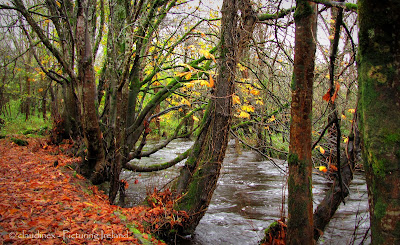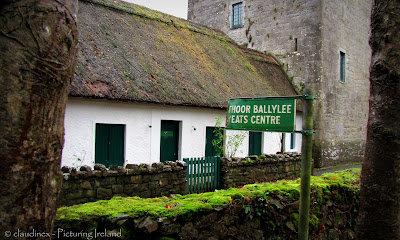This 16th century tower on the banks of the river Streamstown near the market town of Gort in Co. Galway was once the home of no other than Nobel laureate for Literature and Ireland’s most famous poet, William Butler Yeats.
(Scroll down for German version)
The fortified tower was built by the most prolific castle builders
in the west of Ireland at the time – the influential Hiberno-Norman de Burgo or
Burke family who became the Earls of Clanricarde. By the 1850s, the castle and
lands at Ballylee in the barony of Kiltartan was part of the extensive Coole Park
estate of Sir William Henry Gregory, politician and more prominently, husband
of Lady Augusta Gregory. Lady Augusta is of course mainly remembered for her
role in the Irish Literary Revival in the late 19th and early 20th
century. Her Galway home in Coole Park was the meeting place and retreat for
writers and artists like George Bernard Shaw, Seán O'Casey, J.M. Synge, Edward
Martyn, Douglas Hyde and W.B. Yeats.
 |
| The Streamstown river |
I, the poet William Yeats,
With old mill boards and sea-green slates,
And smithy work from the Gort forge,
Restored this tower for my wife George;
And may these characters remain
When all is ruin once again.
 |
| The inscribed poem |
Yeats, George, and their two children Anne and Michael used the castle mostly as a summer home. The seclusion and beautiful surroundings inspired Yeats to write and dedicate many of his poems to the castle, like “The Celtic Twilight”, “The Winding Stairs” and “The Tower” collection.
Dieser Turm aus dem 16. Jahrhundert am Ufer des Flusses Streamstown in der Nähe der Marktgemeinde Gort in der Grafschaft Galway war einst das Zuhause von keinem Geringeren als dem Literaturnobelpreisträger und berühmtesten Dichter Irlands, William Butler Yeats.
Ich, der
Dichter William Yeats,
Mit alten
Mühlenbrettern und meergrünen Schieferplatten,
Und
Schmiedearbeiten aus der Schmiede von Gort,
restaurierte
diesen Turm für meine Frau George;
Und mögen
diese Zeichen bleiben
Wenn alles
wieder ruiniert ist.
Yeats, George und ihre beiden Kinder Anne und Michael nutzten das Schloss hauptsächlich als Sommerresidenz. Die Abgeschiedenheit und die schöne Umgebung inspirierten Yeats dazu, viele seiner Gedichte zu schreiben und dem Schloss zu widmen, wie z. B. "The Celtic Twilight", "The Winding Stairs" und die Sammlung "The Tower".
Nach 1928 begann sich Yeats' Gesundheit zu verschlechtern, und die Familie verbrachte die Sommer zunehmend anderswo. Als Lady Gregory 1932 starb, kamen sie nicht mehr nach Thoor Ballylee, und die Gebäude verfielen schließlich. Lange nach dem Tod von W.B. Yeats übergab sein Sohn Michael den Turm in die Obhut von Ireland West, und einige Jahre später übernahm Fáilte Ireland die Bewahrung des historischen Gebäudes. Im Jahr 2014 pachtete die lokale Gemeindegruppe "The Yeats Thoor Ballylee Society" den Turm von Fáilte Ireland, restaurierte ihn und öffnete ihn 2015 für die Öffentlichkeit. Er beherbergt nun eine Ausstellung und bietet in den Sommermonaten literarische Veranstaltungen. Heutzutage wird Thoor Ballylee oft als "Yeats' Tower" bezeichnet und ist zu einem ikonischen Ort für literarische Pilger aus der ganzen Welt geworden. Seamus Heaney nannte ihn sogar "das wichtigste öffentliche Gebäude in Irland".














Ireland have a lot of incredible places like thats that you post on the photographs. The incredible tower, the beautiful Green wood. The nearest River. It is a good place for travel or for to live in It.
ReplyDelete